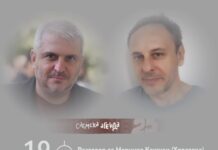
Text.mk: On July 26th, during the central manifestation of the rememberance day of the eartquake that hit Skopje in 1963, Your exhibition was displayed at the Museum of the City of Skopje. What was the title of the exhibition, what did it show?
MS: The title “CONCRETE MEMORIES” has a double 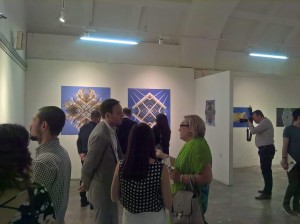 meaning but only in the English language. On one side “concrete” or cement means a building material which – in a simple form – exists for millennia. Fair-faced concrete was used to rebuild Skopje in the 1963 post-earthquake period as an important building material and as a significant characteristic of the so called brutalist architectural style. Generally Architecture – and this specific modernist style particularly – is a part of the cultural memory of a society and in this meaning part of an objective or inter-individual memory. But “concrete” memories also means specific individual memories. Often individual memories are triggered by architecture which surrounds us. So my personal memory of the time I spend in Skopje is essentially influenced by the buildings and the urban infrastructure of Skopje. But of course also by the people I met, who where mainly very friendly by the way…I came to Skopje in May/June 2017 with a stipend from the City of Dresden to create a work which is related to both of the cities. 2017 Skopje and Dresden celebrate the 50 anniversary of their twinning. The GDR Red Cross which was based in Dresden at this time coordinated the help and rebuilding projects after the earthquake 1963. Four years later the both cities became sister cities.
meaning but only in the English language. On one side “concrete” or cement means a building material which – in a simple form – exists for millennia. Fair-faced concrete was used to rebuild Skopje in the 1963 post-earthquake period as an important building material and as a significant characteristic of the so called brutalist architectural style. Generally Architecture – and this specific modernist style particularly – is a part of the cultural memory of a society and in this meaning part of an objective or inter-individual memory. But “concrete” memories also means specific individual memories. Often individual memories are triggered by architecture which surrounds us. So my personal memory of the time I spend in Skopje is essentially influenced by the buildings and the urban infrastructure of Skopje. But of course also by the people I met, who where mainly very friendly by the way…I came to Skopje in May/June 2017 with a stipend from the City of Dresden to create a work which is related to both of the cities. 2017 Skopje and Dresden celebrate the 50 anniversary of their twinning. The GDR Red Cross which was based in Dresden at this time coordinated the help and rebuilding projects after the earthquake 1963. Four years later the both cities became sister cities.
Text.mk: Would You tell us in short, what were the reactions and comments of the visitors?
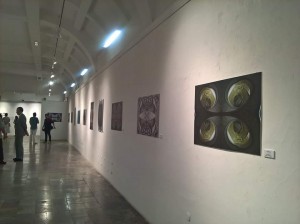 MS: I do unfortunately not speak any Macedonian but to me the reaction of the visitors seemed to be very positive, most people spent some time in front of the photographs and told me that they liked it. Especially interesting to me was the variety of people who came to the opening and liked it, from school kids to old fine art painting professors. As photographer it makes me happy if people with different backgrounds can find inspiration in my pictures. Even the catalogs which were pined at the entrance of the museum as information material were taken away. So I guess people got inspired;-)
MS: I do unfortunately not speak any Macedonian but to me the reaction of the visitors seemed to be very positive, most people spent some time in front of the photographs and told me that they liked it. Especially interesting to me was the variety of people who came to the opening and liked it, from school kids to old fine art painting professors. As photographer it makes me happy if people with different backgrounds can find inspiration in my pictures. Even the catalogs which were pined at the entrance of the museum as information material were taken away. So I guess people got inspired;-)
Text.mk: I can say, impressive and unusual were Your photos of “a different Skopje”, in a different dimension. To illustrate, photographed parts and elements of buildings built in the communist period, depicted in a specific vision of yours. And also multiplied. What idea and message did this photos contain?
MS: First of all I would like to pay generally 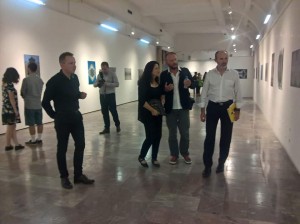 attention to this specific historical period of Modernist / Brutalist architecture in Skopje. As far as I know Skopje houses the most brutalist buildings and architectural ensembles beside London/UK (and perhaps Belgrade) of this style in Europe, perhaps in the world.This is a undiscovered treasure that the people of Skopje should be aware of.Even if you don´t like the architectural style itself, this buildings shape the face of Skopje making it distinctive to any other european city. I also want to show the sculptural potential which this architectural style still contains.
attention to this specific historical period of Modernist / Brutalist architecture in Skopje. As far as I know Skopje houses the most brutalist buildings and architectural ensembles beside London/UK (and perhaps Belgrade) of this style in Europe, perhaps in the world.This is a undiscovered treasure that the people of Skopje should be aware of.Even if you don´t like the architectural style itself, this buildings shape the face of Skopje making it distinctive to any other european city. I also want to show the sculptural potential which this architectural style still contains.
Text.mk: How did you come to the idea of this kind of photos, is this your specialty in photographic and visionary work?
MS: To be honest, I do not remember the exact time when I got the idea. Maybe the patterns and the rhythm of the architectural details of the buildings such as the central post office or Goce Delchev student dormitories made me think about that specific photographic way to highlight and interpret this modernist approach. Usually I am not focused on one particular photographic method or style. It usually depends on the subject of my interest. I try to find out which photographic method or approach fits the best to that subject. I have even worked in the field of land art to express some photographic ideas about perception.
Text.mk: What is this technique called?
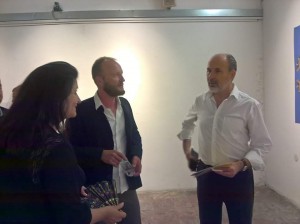 MS: If you find a catchy word for that technique please let me know;-) You can call this sort of doubling and mirroring only one photographic motif not exactly a collage because the basis of a collage are usually different fragments or parts.
MS: If you find a catchy word for that technique please let me know;-) You can call this sort of doubling and mirroring only one photographic motif not exactly a collage because the basis of a collage are usually different fragments or parts.
Text.mk: Have you made another such exhibition or similar to this one, somewhere else?
MS: During the last years because of personal circumstances I did not make a lot of solo exhibitions. For five years until this year I used to run a little photo gallery “NEUE OSTEN” (new east) in Dresden which presented photography from and about (South-) East Europe. I am personally very much interested in (South) Eastern European life and people. Maybe because I spend the first years of my life in the GDR it inspires me a lot when I travel through this European regions.
Text.mk: What impressed You most about buildings built in communism?
MS: I think we should distinguish between the time and the political circumstances in which 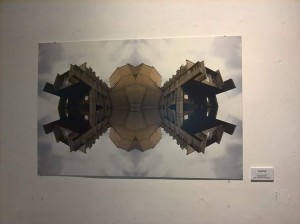 this buildings were built and the architectural quality of the buildings itself. Only because those buildings where made during communist times makes them not to genuine “communistic architecture” In my opinion Skopje is a good example of the interaction of international modernistic influences and the work of Yugoslavian/Macedonian urbanists and architects. To me as an non-expert the architectural style of this decades was international at least in Skopje. During the last two decades there was a big discussion also in Dresden about what to do with this so called “socialist” architecture. Accepting it as part of the cities history or removing it because of its problematic political heritage which its used to represent?
this buildings were built and the architectural quality of the buildings itself. Only because those buildings where made during communist times makes them not to genuine “communistic architecture” In my opinion Skopje is a good example of the interaction of international modernistic influences and the work of Yugoslavian/Macedonian urbanists and architects. To me as an non-expert the architectural style of this decades was international at least in Skopje. During the last two decades there was a big discussion also in Dresden about what to do with this so called “socialist” architecture. Accepting it as part of the cities history or removing it because of its problematic political heritage which its used to represent?
Text.mk: In Your opinion, what is the most beautiful building built in that period, in Skopje, but also in the world?
MS: I would not say those brutalist modernist buildings are beautiful. In the internet I found the description “beautiful monsters”. That describes the best my ambivalent relation to that modernist style. I grew up in a very old farm house. Maybe that’s why I am also fascinated about those avant-garde modernist buildings. In Skopje I like very much the post office even so it is now surrounded by other buildings. In Dre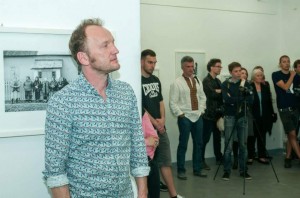 sden I like the cultural palace of culture which was restored and re-opened to the public a few month ago.
sden I like the cultural palace of culture which was restored and re-opened to the public a few month ago.
Text.mk: Do You come often in Skopje?
MS: This was my third time here but I am planing to come to Skopje or better to some other parts of Macedonia in October. Despite of Skopje I have not seen much of the country. But I am curious to see more.
Text.mk: Do You have friends here or collaborators?
MS: During my visit I made some new friends. People here are very open minded and interested in others.
Text.mk: Dresden and Skopje are twin-cities, 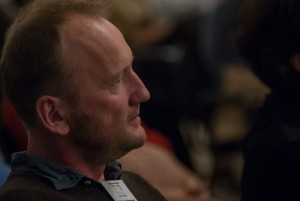 so it’s very likely to get new invitations. Do You make plans for Your next exhibition in another place, in this style?
so it’s very likely to get new invitations. Do You make plans for Your next exhibition in another place, in this style?
MS: For next year an exhibition is planned in Dresden combining positions from photographers from Skopje and Dresden. There I will show some of the photographs too.
Text.mk: At the end of this interview, briefly present us what you have most worked on as a photographer, and what exhibitions did you have?
MS: My artistic photographic work circles around the phenomena of perception, illusion and memory. The “concrete” subject I often find on my journeys through South-Eastern Europe. I also make reportage and photo essay about the areas I am travelling. Right now I am focusing more on architecture.
Valentina Gjorgievska Pargo












